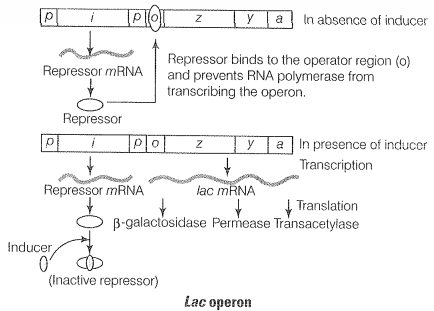Q. 5. Define an operon, giving an example, explain an inducible operon.
The concept of the operon was first proposed in 1961, by Jacob and Monad. An operon is a unit of prokaryotic gene expression which includes coordinately regulated (structural) genes and control elements which are recognised by regulatory gene product.
Components of an Operon
(i) Structural gene The fragment of DNA which transcribes mRNA for polypeptide synthesis.
(ii) Promoter The sequence of DNA where RNA polymerase binds and initiates transcription of structural genes is called the promoter.
(iii) Operator The sequence of DNA adjacent to promoter where specific repressor protein binds is called the operator.
(iv) Regular gene The gene that codes for the repressor protein that binds to the operator and suppresses its activity as a result of which transcription will be switched off.
(v) Inducer The substrate that prevents the repressor from binding to the operator, is called an inducer. Asa result transcription is switched on. It is a chemical of diverse nature like metabolite, hormone substrate, etc,
Inducible Operon System
An inducible operon system is a regulated unit of genetic material which is switched on in response to the presence of a chemical. e.g., the lactose or lac-operon of E.coli.
The lactose operon The lac z, y, genes are transcribed from a lac transcription unit under the control of a single promoter. They encode the enzyme required for the use of lactose as a carbon source. The lac i gene product, the lac repressor, is expressed from a separate transcription unit upstream from the operator.
lac operon consists of three structural genes (z, y and a), operator, promoter and a separate regulatory gene.
The three structural genes (a, y and a) transcribe a polycistronic mRNA.

Gene z codes for -galactosidase (-gal) enzyme which breaks lactose into galactose and glucose.
Gene y codes for permease, which increases the permeability of the cell to lactose.
Gene codes for enzyme transacetylase, which catalyses the transacetylase, which catalyses the transacetylation or lactose in its active form.
When Lactose is Absent
(i) When lactose is absent, i gene regulates and produces a repressor mRNA which translates repression.
(ii) The repressor protein binds to the operator region of the operon and as a result prevents RNA polymerase to bind to the operon.
(iii) The operon is switched off.
When Lactose is Present
(i) Lactose acts as an inducer which binds to the repressor and forms an inactive repressor.
(ii) The repressor fails to bind to the operator region.
(iii) The RNA polymerase binds to the operator and transcript lac mRNA.
(iv) lac mRNA is polycistronic, i.e., produces all three enzymes, -galactosidase, permease and transacetylase.
(v) The lac operon is switched on.